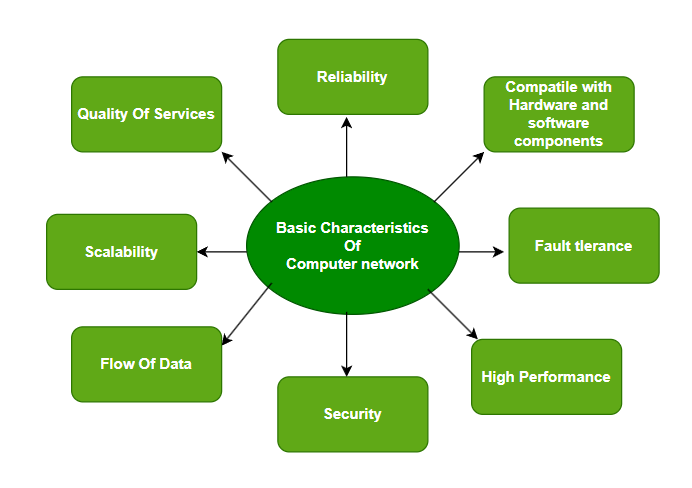Understanding Computer Networks
Computer networks connect devices and enable resource sharing across various scales, from small office setups to global systems. These interconnected systems have transformed how we share information and collaborate in the digital age.
Computer networks allow multiple devices to communicate and share resources including files, hardware, software, internet access, and processing power. Their effectiveness depends on several key characteristics.

Key characteristics of computer networks
Core Characteristics
1. Security
Network security protects sensitive data and systems from threats. Key security aspects include:
- Access control mechanisms
- Data encryption
- Malware protection
- Intrusion detection
Modern networks use firewalls, encryption, and authentication to safeguard against unauthorized access and attacks.
2. Reliability
Reliable networks provide consistent service availability through:
- Minimal downtime
- Consistent performance under varying loads
- Redundant systems
- Failover mechanisms
This reliability is achieved through backup systems and fault-tolerant architectures.
3. Scalability
Scalable networks grow to meet increasing demands without performance degradation, supporting:
- Business expansion
- Increased user loads
- New applications and services
The internet exemplifies scalability, connecting billions of devices while maintaining functionality.
4. Data Flow Management
Efficient networks optimize how information moves between nodes through:
- Strategic packet routing
- Traffic prioritization
- Congestion control
- Bandwidth allocation
These mechanisms ensure critical information reaches its destination promptly.
5. Performance
Network performance affects user experience and productivity. Key factors include:
- Bandwidth capacity
- Latency (transmission delay)
- Throughput (actual data transfer rate)
- Application response time
High-performance networks use optimized hardware, protocols, and traffic management.
6. Fault Tolerance
Fault-tolerant networks continue functioning despite component failures through:
- Redundant communication paths
- Automatic failover systems
- Error detection and correction
- Distributed architectures
If one connection fails, traffic automatically reroutes through alternative paths.
7. Quality of Service (QoS)
QoS mechanisms prioritize network traffic based on importance:
- Critical applications receive necessary bandwidth
- Time-sensitive data gets priority
- Resource allocation matches application needs
This is crucial for networks handling diverse traffic types with varying sensitivity to delays.
8. Interoperability
Interoperability ensures diverse components work together:
- Equipment from different vendors
- Various operating systems
- Legacy and new technologies
- Standardized protocols
This maximizes flexibility and extends the useful life of existing investments.
Additional Characteristics
Connectivity Technologies
Networks use various connection methods:
- Wired (Ethernet, fiber optic)
- Wireless (Wi-Fi, Bluetooth, cellular)
- Satellite communications
Each offers different advantages in speed, range, and reliability.
Standards and Protocols
Standardized protocols enable consistent communication:
- TCP/IP for internet
- HTTP/HTTPS for web traffic
- SMTP/POP3/IMAP for email
- IEEE 802.11 for wireless networking
Network Management
Effective management maintains optimal operation through:
- Continuous monitoring
- Configuration management
- Capacity planning
- Troubleshooting
Conclusion
The fundamental characteristics of computer networks—security, reliability, scalability, data flow management, performance, fault tolerance, quality of service, and interoperability—create robust communication systems that adapt to evolving technological landscapes and user needs.
Test Your Knowledge
Take a quiz to reinforce what you've learned
Exam Preparation
Access short and long answer questions for written exams